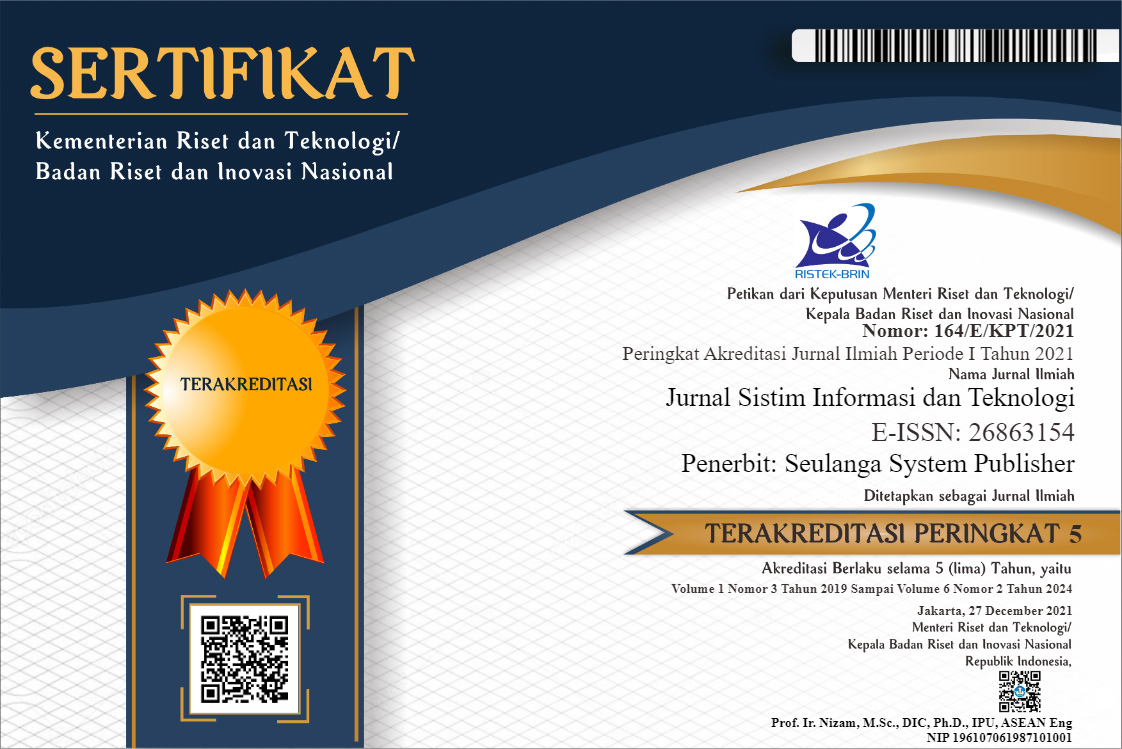Prediksi Kuantitas Penggunaan Obat pada Layanan Kesehatan Menggunakan Algoritma Backpropagation Neural Network
DOI:
https://doi.org/10.37034/jsisfotek.v4i3.158Keywords:
Prediction, Drug Use, Artificial Neural Network, Backpropagation, Mean Absolute Percentage Error (MAPE)Abstract
Prediction of the amount of drug use at public health centers is needed to ensure the availability of drugs for patients in service quality management. A good prediction of the amount of medicine needed helps the quality of development planning in the health sector. Scientific developments in the field of Artificial Intelligence (AI) deliver a variety of the best techniques for making predictions. By adopting the workings of neural networks (neurons) in the human brain or Artificial Neural Network (ANN), the Backpropagation Neural Network (BPNN) algorithm is one of the best algorithms in making predictions, including predicting drug use in health services. The problem of this research is how to design the best architectural model such as the number of neurons in the input layer, hidden layer and other parameters so as to produce predictions with optimal accuracy. This study aims to develop an ANN architectural design with the Backpropagation algorithm to predict the need for drug use. The data used is data on drug use reports from 2015 to 2021 at the Andalas Community Health Center (Puskesmas) Padang City. The steps taken to predict are; collect data, pre-process data and perform analysis, design ANN architecture, make predictions. Learning using the backpropagation algorithm through the initial weight initialization process, activation stage, weight training (weight change) and iteration stage. The proportion of the amount of data used for training is 70% data and 30% for testing data. The results of this study indicate that the best ANN architecture is 12-12-1 with an accuracy of predicting the quantity of drug use reaching 97.87% for paracetamol with a Mean Absolute Percentage Error (MAPE) of 2.13%. The prediction results become a reference for the Puskesmas and the Health Office for service planning and development.
References
Kolluri, S., Lin, J., Liu, R., Zhang, Y., & Zhang, W. (2022). Machine Learning and Artificial Intelligence in Pharmaceutical Research and Development: a Review. Injury, 1–10. https://doi.org/10.1016/j.injury.2022.01.046
Abbas, K., Afaq, M., Khan, T. A., & Song, W. C. (2020). A blockchain and machine learning-based drug supply chain management and recommendation system for smart pharmaceutical industry. Electronics (Switzerland), 9(5), 1–31. https://doi.org/10.3390/electronics9050852
He, B., Han, W., & Hon, S. Y. I. (2022). A Machine Learning Approach: Enhancing the Predictive Performance of Pharmaceutical Stock Price Movement during COVID. Journal of Data Analysis and Information Processing, 10(01), 1–21. https://doi.org/10.4236/jdaip.2022.101001
Thakkar, A., & Chaudhari, K. (2021). A comprehensive survey on deep neural networks for stock market: The need, challenges, and future directions. In Expert Systems with Applications (Vol. 177). https://doi.org/10.1016/j.eswa.2021.114800
Safari, A., & Ghavifekr, A. A. (2021). International Stock Index Prediction Using Artificial Neural Network (ANN) and Python Programming. 2021 7th International Conference on Control, Instrumentation and Automation, ICCIA 2021. https://doi.org/10.1109/ICCIA52082.2021.9403580
Wang, S., Di, J., Wang, D., Dai, X., Hua, Y., Gao, X., Zheng, A., & Gao, J. (2022). State-of-the-Art Review of Artificial Neural Networks to Predict, Characterize and Optimize Pharmaceutical Formulation. Pharmaceutics, 14(1), 183. https://doi.org/10.3390/pharmaceutics14010183
Wang, H., Hong, M., & Hong, Z. (2021). Research on BP Neural Network Recommendation Model Fusing User Reviews and Ratings. IEEE Access, 9, 86728–86738. https://doi.org/10.1109/ACCESS.2021.3080079
Sijabat, P. I., Yuhandri, Y., Nurcahyo, G. W., & Sindar, A. (2020). Algoritma Backpropagation Prediksi Harga Komoditi terhadap Karakteristik Konsumen Produk Kopi Lokal Nasional. Digital Zone: Jurnal Teknologi Informasi Dan Komunikasi, 11(1), 96-107.
Du, M., Luo, J., Wang, S., & Liu, S. (2020). Genetic algorithm combined with BP neural network in hospital drug inventory management system. Neural Computing and Applications, 32(7), 1981–1994. https://doi.org/10.1007/s00521-019-04379-3
Jamous, R., Alrahhal, H., & El-Darieby, M. (2021). A New ANN-Particle Swarm Optimization with Center of Gravity (ANN-PSOCoG) Prediction Model for the Stock Market under the Effect of COVID-19. Scientific Programming, 2021, 1–17. https://doi.org/10.1155/2021/6656150
Zhu, T., Li, K., Herrero, P., & Georgiou, P. (2021). Deep Learning for Diabetes: A Systematic Review. IEEE Journal of Biomedical and Health Informatics, 25(7), 2744–2757. https://doi.org/10.1109/JBHI.2020.3040225
Wei, W., & Yang, X. (2021). Comparison of diagnosis accuracy between a backpropagation artificial neural network model and linear regression in digestive disease patients: An empirical research. Computational and Mathematical Methods in Medicine, 2021. https://doi.org/10.1155/2021/6662779
Zhang, H., & Mu, J.-H. (2021). A Back Propagation Neural Network-Based Method for Intelligent Decision-Making. Complexity, 2021, 1–11. https://doi.org/10.1155/2021/6610797
Wang, G., Jia, Q. S., Zhou, M., Bi, J., Qiao, J., & Abusorrah, A. (2021). Artificial neural networks for water quality soft-sensing in wastewater treatment: a review. Artificial Intelligence Review, 1-23. https://doi.org/10.1007/s10462-021-10038-8
Shukla, P. K., Shukla, P. K., Sharma, P., Rawat, P., Samar, J., Moriwal, R., & Kaur, M. (2020). Efficient prediction of drug–drug interaction using deep learning models. IET Systems Biology, 14(4), 211–216. https://doi.org/10.1049/iet-syb.2019.0116
Manni, A., Saviano, G., & Bonelli, M. G. (2021). Optimization of the ANNs Predictive Capability Using the Taguchi Approach: A Case Study. Mathematics, 9(7), 1–16. https://doi.org/10.3390/math9070766
Zwaida, T. A., Pham, C., & Beauregard, Y. (2021). Optimization of inventory management to prevent drug shortages in the hospital supply chain. Applied Sciences (Switzerland), 11(6). https://doi.org/10.3390/app11062726
Thoriq, M. (2022). Peramalan Jumlah Permintaan Produksi Menggunakan Jaringan Saraf Tiruan Algoritma Backpropagation. Jurnal Informasi Dan Teknologi, 4, 27–32. https://doi.org/10.37034/jidt.v4i1.178
Putra, H., & Walmi, N. U. (2020). Penerapan Prediksi Produksi Padi Menggunakan Artificial Neural Network Algoritma Backpropagation. Jurnal Nasional Teknologi Dan Sistem Informasi, 6(2), 100–107. https://doi.org/10.25077/teknosi.v6i2.2020.100-107
Abdullah, D., Pardede, A. M. H., Umami, L., Manurung, R., Suryani, R., Surya, S., Saddhono, K., Mulyaningsih, I., Sudarsana, I. K., Brata, D., Mahatmaharti, R. A. K., Novziransyah, N., Amalia, A., Effendi, S., Samidah, I., & Murwati, M. (2020). Drug Users Prediction Using Backpropagation Educational Method. Journal of Physics: Conference Series, 1361(1). https://doi.org/10.1088/1742-6596/1361/1/012055
Elisawati, E., Linarta, A., Putra, A. M. I., & Elvaningsih, H. (2022). Analysis of Backpropagation Method in Predicting Drug Stock. SinkrOn, 7(2), 297–307. https://doi.org/10.33395/sinkron.v7i2.11269
Elvaningsih, H., Elisawati, Tawakal, F., & Masrizal. (2021). Prediksi Stok Obat Menggunakan Metode Backpropagation (Studi Kasus: Puskesmas Dumai Barat). Seminar Nasional Sains Dan Teknologi Informasi (SENSASI), 228–232. https://prosiding.seminar-id.com/index.php/sensasi/article/view/588/569
Abdianto, D., Elisawati, Tawakal, F., & Masrisal. (2021). Prediksi Stok Obat Menggunakan Metode Learning Vector Quantization Studi Kasus Puskesmas Dumai Barat. Prosiding SNST, Volume 1, 68–74. https://publikasiilmiah.unwahas.ac.id/index.php/PROSIDING_SNST_FT/issue/view/306
Wibowo, P., Suryono, S., & Gunawan, V. (2019). Pengaruh Perbedaan Jumlah Hidden Layer dalam Jaringan Syaraf Tiruan Terhadap Prediksi Kebutuhan Captopril dan Paracetamol pada Rumah Sakit. Jurnal Media Aplikom, 11(2), 45–58.
S. H. Putri, Y. Yuhandri, and G. W. Nurcahyo, “Prediksi Pencapaian Target Peserta Keluarga Berencana Pasca Persalinan menggunakan Algoritma Backpropagation,” Jurnal Sistim Informasi. dan Teknologi., vol. 3, pp. 176–182, 2021, doi: 10.37034/jsisfotek.v3i3.62.
W. Satria, “Jaringan Syaraf Tiruan Backpropagation Untuk Peramalan Penjualan Produk (Studi Kasus Di Metro Electronic Dan Furniture),” Djtechno J. Teknol. Inf., vol. 1, no. 1, pp. 14–19, Jun. 2021, doi: 10.46576/djtechno.v1i1.966.
Downloads
Published
How to Cite
Issue
Section
License
Copyright (c) 2022 Jurnal Sistim Informasi dan Teknologi

This work is licensed under a Creative Commons Attribution 4.0 International License.









